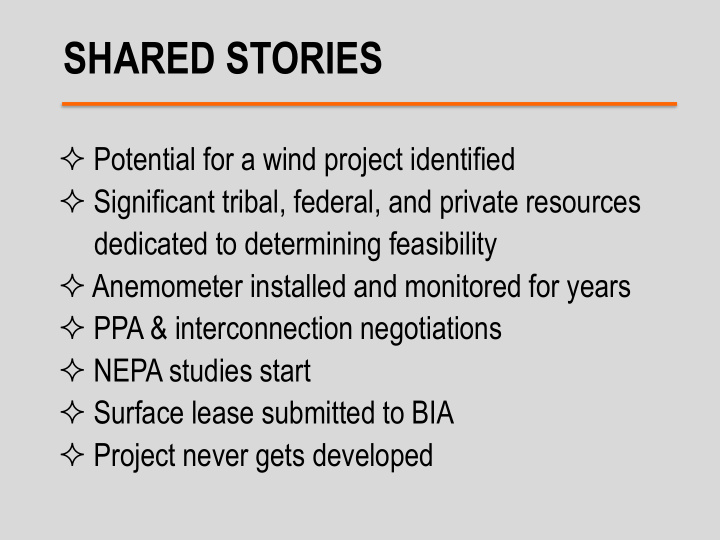



SHARED STORIES Potential for a wind project identified Significant tribal, federal, and private resources dedicated to determining feasibility Anemometer installed and monitored for years PPA & interconnection negotiations NEPA studies start Surface lease submitted to BIA Project never gets developed
SHARED STORIES Oil and gas resources identified Tribe and members see development all around Seek developers to open negotiations Developer requests land title status reports to BIA Developer and tribe submit request for a lease sale Oil and gas resources remain undeveloped
WHY? Chairman Barrasso from Senate Committee on Indian Affairs submits a request to GAO to identify the factors that are leading to these shared experiences. The Committee wanted GAO to examine the following: (1) Factors that have hindered Indian energy resource development (2) Factors that have deterred tribes from seeking Tribal Energy Resource Agreements (TERA) (3) The effectiveness of Tribal Energy Development Capacity grants to build tribes’ capacity to enter into TERAs
GAO
Report released in June 2015 INDIAN ENERGY DEVELOPMENT: Poor Management by BIA Has Hindered Energy Development on Indian Lands Oversight hearing before Senate Committee on Indian Affairs in October 2015
GENERAL BACKGROUND Federal policy promotes and supports opportunities for increased tribal self-governance and greater tribal autonomy According to literature we reviewed, successful tribal economic development depends in part on tribal control and decision-making authority over the activities that affect the tribe and its tribal members.
BACKGROUND Federal government’s transition from decision maker to advisor, from controlling the process to providing information and technical assistance to tribes. Guiding principles of the trust relationship: • supporting tribal sovereignty • Indian tribes have the right to make important decisions about their own best interests • Interior agencies are to practice responsiveness and timeliness ( Secretarial Order 3335 )
BACKGROUND HEARTH Act : Tribes can develop and implement their own regulations governing leasing of Indian lands for residential, business, renewable energy, and other purposes. Upon approval of its regulations by Interior, a tribe may process these leases without first obtaining approval from BIA .
BACKGROUND Indian Tribal Energy Development and Self-Determination Act (ITEDSA) of 2005 provides an option for tribes to exercise greater control of decision-making authority over their own energy resources . The ITEDSA provides for interested tribes to pursue a Tribal Energy Resource Agreement (TERA) — an agreement between a tribe and the Secretary of the Interior that allows the tribe, at its discretion, to enter into leases, business agreements, and ROW agreements for energy resource development on tribal lands without review and approval by the Secretary .
SENATE COMMITTEE ON INDIAN AFFAIRS
HINDERING FACTORS Shortcomings in BIA’s management: BIA does not have comprehensive data identifying ownership and use of Indian resources Cadastral surveys cannot be found or are outdated BIA does not have comprehensive GIS mapping data identifying resource ownership and use of resources Troubles obtaining information that does exist As a result, for example, leases cannot be approved or use of resources cannot be identified in a timely manner.
HINDERING FACTORS Shortcomings in BIA’s management: BIA does not have a documented process or data to track its review and response times We could not identify how long it takes BIA to complete reviews Lost documents Refusal to take action
HINDERING FACTORS BIA’s review process can be lengthy and increase development costs and project development times, resulting in missed development opportunities , lost revenue , and jeopardized viability of projects . Energy-related documents taking years for BIA review and approval. ROW agreements that took up to 8 years for approval Communitization agreements Surface leases
HINDERING FACTORS Shortcomings in BIA’s management: Some BIA regional and agency offices do not have staff with the skills needed to effectively evaluate energy-related documents or adequate staff resources.
HINDERING FACTORS Complex regulatory framework with multiple jurisdictions: More steps, increased development costs, longer timelines According to an industry representative, development of Indian resources can cost almost 65% more for regulatory compliance. Stakeholders told us that: Development is generally not managed according to tribal priorities. Current framework does not reflect that Indian lands are intended for the use and benefit of Indian tribes & members. Indian lands being managed according to priorities generally associated with public lands.
HINDERING FACTORS Fractionated land ownership interests: Can create a problem for leasing Tribes’ access to capital and federal tax credits: Limited opportunities to take advantage of federal tax credits to develop their own resources Dual Taxation: Tribal & state severance taxes Renewable energy equipment
HINDERING FACTORS Tribal capacity: Concerns about underdeveloped tribal legal infrastructure, outdated tribal governance structures, and politicized business management. Need for modern, comprehensive, and culturally appropriate business and commercial laws or codes. Infrastructure limitations: Lack proximate access to connect with the electrical grid. Limited access to transportation linkages to processing facilities.
RECOMMENDATIONS 1) BIA should improve GIS mapping capabilities. 2) BIA should identify cadastral survey needs. 3) BIA should develop a process to track its review and response times. 4) BIA should ensure it has the data needed to track its review and response times. 5) Interior should provide additional guidance on unclear provisions of TERA. 6) Interior should evaluate effectiveness of TEDC grants. 7) Interior should identify features of the TEDC program that can limit effectiveness of the program.
CURRENT REVIEW Solutions focused What has been done? What is being pursued? What can be done? Federal assistance? Tribal solutions
CURRENT REVIEW Financial and technical assistance available from federal agencies • Access to assistance?
DISCUSSION TOPICS Tribal energy needs/ goals/ interests Experiences with energy development Experiences with federal assistance Suggestions for improvements Increased tribal control over development process or providing access to energy
CONTACT INFORMATION Jay Spaan SpaanJ@gao.gov 214-777-5636
Recommend
More recommend